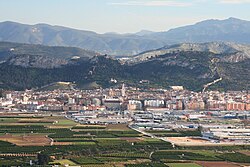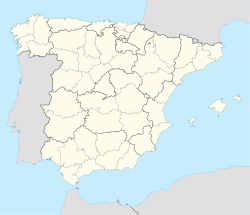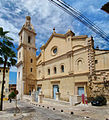Xàtiva
You can help expand this article with text translated from the corresponding article in Spanish. (January 2017) Click [show] for important translation instructions.
|
Xàtiva
| |
|---|---|
 View of Xàtiva | |
 Location of Xàtiva | |
| Coordinates: 38°59′25″N 0°31′16″W / 38.99028°N 0.52111°W | |
| Country | |
| Autonomous community | |
| Province | |
| Comarca | Costera |
| Judicial district | Xàtiva |
| Government | |
| • Mayor | Roger Cerdà i Boluda (2015) (PSPV-PSOE) |
| Area | |
• Total | 76.56 km2 (29.56 sq mi) |
| Elevation | 115 m (377 ft) |
| Population (2018)[1] | |
• Total | 29,045 |
| • Density | 380/km2 (980/sq mi) |
| Demonym(s) | xativí, -ina (Val.) jativés, -esa / setabense (Sp.) |
| Time zone | UTC+1 (CET) |
| • Summer (DST) | UTC+2 (CEST) |
| Postal code | 46800 |
| Official language(s) | Spanish and Valencian |
| Website | www.xativa.es |
Xàtiva (Valencian: [ˈʃativa]; Spanish: Játiva [ˈxatiβa]) is a town in eastern Spain, in the province of Valencia, on the right (western) bank of the river Albaida and at the junction of the Valencia–Murcia and Valencia Albacete railways.[2] It is located 25 km west of the Mediterranean Sea. During the Al-Andalus Islamic era, Arabs brought the technology to manufacture paper to Xàtiva. In the 12th century, Xàtiva was known for its schools, education, and learning circles. Islamic scholar Abu Ishaq al-Shatibi's last name refers to Xàtiva where he lived and died.[3] After the Reconquista by Northern Christian kingdoms and the following Christian repopulation, the city became the cradle of one of the most powerful and controversial families of the Renaissance, the House of Borgia, which produced Popes like Callixtus III (Alfonso de Borgia) and Alexander VI (Rodrigo de Borgia).
History
[edit]
Xàtiva (Saetabis in Latin)[4] was famous in Roman times for its linen fabrics, mentioned by the Latin poets Ovid and Catullus. Xàtiva is also known as an early European centre of paper manufacture. In the 12th century, Arabs brought the technology to manufacture paper to Xàtiva (Arabic: شاطبة Shāṭiba).
It is the birthplace of two popes, Callixtus III and Alexander VI, and also the painter José Ribera (Lo Spagnoletto). It suffered a dark moment in its history at the hands of Philip V of Spain, who, after his victory at the Battle of Almansa during the War of the Spanish Succession, had the city besieged then ordered it to be burned and renamed San Felipe. In memory of the insult, the portrait of the monarch hangs upside down in the local museum of l'Almodí.[5]
Xàtiva was briefly a provincial capital under the short-lived 1822 territorial division of Spain,[6] during the Trienio Liberal. The Province of Xàtiva was revoked with the return to absolutism in 1823.
Main sights
[edit]Xàtiva is built on the margin of a fertile plain, and on the northern slopes of the Monte Vernissa, a hill with two peaks crowned by Xativa Castle.[2]
The Collegiate Basilica, dating from 1414, but rebuilt about a century later in the Renaissance style, was formerly a cathedral, and is the chief among many churches and convents. The town-hall and a church on the castle hill are partly constructed of inscribed Roman masonry, and several houses date from the Moorish period.[2]
Other sights include:
- Royal Monastery of the Assumption, Gothic and Baroque style, built during the 14th century and renovated in the 16th–18th centuries.
- Natal house of the Pope Alexander VI.
- Sant Feliu (St Felix) – 13th century church.
- Sant Pere (St Peter) – 14th century church. The interior has a Coffered ceiling decorated in Gothic-Mudéjar style.
- Hermitage of Santa Anna (15th century), in Gothic style.
- Almodí, a 14th-century Gothic edifice (1530–1548) now housing a Museum.
- Casa de l'Ensenyança, Xàtiva.
- Sant Francesc.
- Village of Anahuir.

Notable people
[edit]- Abu al-Qasim al-Shatibi (538–590 AH / 1144–1194 CE)
- Abu Ishaq al-Shatibi (720–790 AH / 1320–1388 CE)
- Pope Calixtus III (1378–1458)
- Pope Alexander VI (1431–1503)
- Tomás Cerdán de Tallada (1530–1614)
- Diego Ramírez de Arellano (1580–1624)
- Jusepe de Ribera (1591–1652)
- Jaime Villanueva (1765–1824)
- Raimon (born 1940)
- Joan Ramos (born 1942)
- Toni Cucarella (born 1959)
- Feliu Ventura (born 1976)
Gallery
[edit]-
Drawing of Xàtiva by Anton van den Wyngaerde in 1563, commissioned by King Philip II of Spain.
-
Portrait of Philip V of Spain purposefully exhibited upside down in the Museum of Almodí
-
Collegiate church
-
Hospital
-
Town hall
See also
[edit]References
[edit]- ^ Municipal Register of Spain 2018. National Statistics Institute.
- ^ a b c One or more of the preceding sentences incorporates text from a publication now in the public domain: Chisholm, Hugh, ed. (1911). "Játiva". Encyclopædia Britannica. Vol. 15 (11th ed.). Cambridge University Press. p. 280.
- ^ Muhammad Khalid Masud, Islamic Legal Philosophy: A Study of Abu Ishaq al-Shatibi's Life and Thought, McGill University 1977
- ^ "Definition - Numen - The Latin Lexicon - An Online Latin Dictionary - A Dictionary of the Latin Language". latinlexicon.org.
- ^ "Objectivas" (in Spanish). Archived from the original on May 27, 2007.
- ^ (in Spanish) División provisional del territorio español de 27 de Enero de 1822 Archived December 14, 2009, at the Wayback Machine, the text of the proposed 1822 territorial division of Spain, Instituto de Historia, Consejo Superior de Investigaciones Cientificas (CSIC, Spanish National Research Council). Accessed online 2010-01-03.
External links
[edit]- Official website

 Media related to Xàtiva at Wikimedia Commons
Media related to Xàtiva at Wikimedia Commons Xàtiva travel guide from Wikivoyage
Xàtiva travel guide from Wikivoyage






![Portrait of Philip V of Spain purposefully exhibited upside down in the Museum of Almodí [es]](http://up.wiki.x.io/wikipedia/commons/thumb/7/7e/X%C3%A0tiva._Almod%C3%AD._Felip_V_i_cadira-2.jpg/90px-X%C3%A0tiva._Almod%C3%AD._Felip_V_i_cadira-2.jpg)



